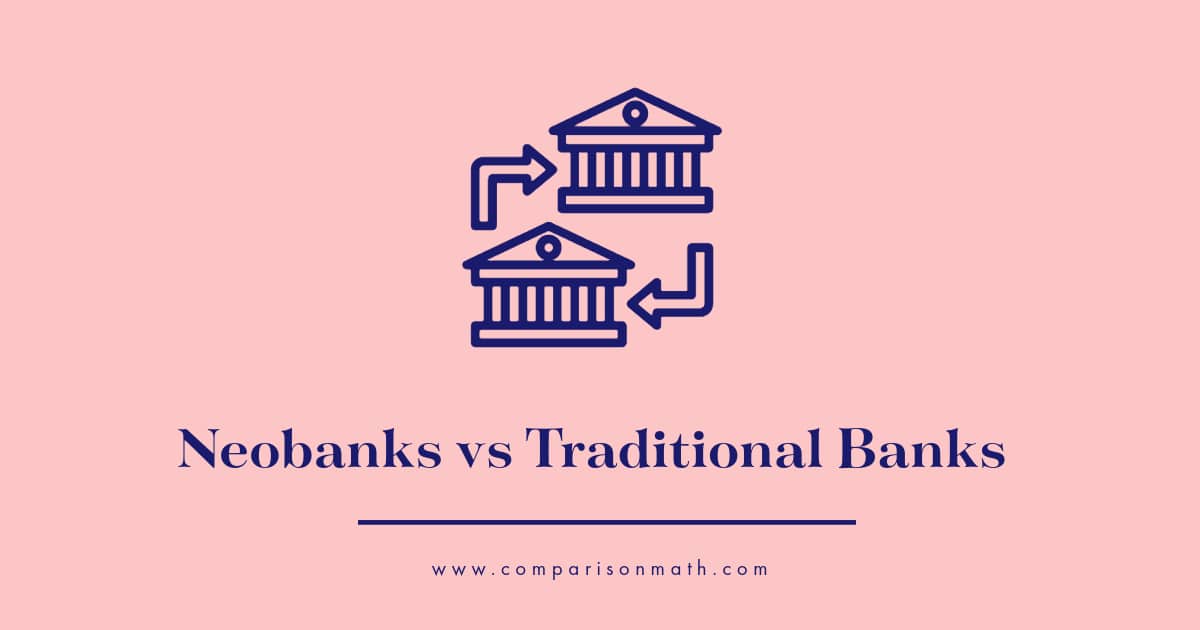Physical Address
304 North Cardinal St.
Dorchester Center, MA 02124

In the ever-evolving landscape of financial services, a new kind of banking has emerged, challenging the traditional models we’ve grown accustomed to. This guide aims to demystify the nuances and intricacies of Neobanks vs Traditional Banks, providing a deep dive into the world of modern banking. As we embark on this journey, let’s unravel the essence of neobanks, understand their place in the current financial ecosystem, and compare them with their traditional counterparts.

The Rise of Neobanks
Neobanks, also known as digital banks, have taken the financial world by storm, offering a purely online banking experience. Unlike traditional banks, they operate without physical branches, bringing a wave of innovation and convenience to the banking sector. Their emergence signals a significant shift in how financial services are consumed and delivered in the digital age.
Traditional Banks: The Cornerstone of the Financial World
Traditional banks, the longstanding pillars of the financial community, have a rich history dating back centuries. These institutions have evolved, yet their core model remains centred around physical branches and a more traditional approach to banking services.
The Importance of This Comparison
As we delve into the detailed comparison of Neobanks vs Traditional Banks, it’s crucial to understand that each has its unique strengths and challenges. This guide will provide you with comprehensive insights, helping you make informed decisions about your banking needs in today’s digital world.
The Digital Banking Revolution
Neobanks often synonymous with terms like ‘digital banks’ or ‘online-only banks’, represent the next wave in financial services. These institutions operate exclusively online, with no physical branches. This section will explore what neobanks are and how they’re changing the face of banking.
Defining Neobanks
A Neobank is more than just an online extension of a traditional bank; it’s a completely digital entity. With a focus on user-friendly interfaces, they offer streamlined, tech-driven financial services. From opening an account to managing finances, everything is done via an app or a website, making banking as simple as scrolling through your smartphone.
The Rise of Neobanks
The emergence of neobanks can be traced back to the early 2010s. Driven by advancements in technology and a shift in consumer preferences, these banks have been gaining significant traction. Especially among millennials and digital natives, neobanks are becoming a popular choice, thanks to their convenience, innovative features, and customer-centric approach.
The Backbone of the Financial Industry
Traditional banks, or ‘brick-and-mortar banks’, have been the foundation of the financial system for centuries. This section aims to shed light on these institutions and their enduring significance in the banking world.
Overview of Traditional Banking Systems
Traditional banks offer a wide range of financial services, including savings and checking accounts, loans, credit facilities, and investment products. Their operation is deeply rooted in physical branches, where customers can walk in for various banking services. This conventional model emphasizes face-to-face interactions and a more hands-on approach to banking.
The Evolution of Conventional Banks
Over the years, traditional banks have evolved to include digital services. However, their core operations still revolve around their physical presence. These banks cater to a broad demographic, including individuals who prefer in-person banking experiences and those who value the comprehensive range of services that traditional banks offer.
In this critical section, we’ll dissect the fundamental differences between neobanks and traditional banks, offering you a clear perspective on each banking model’s unique features and services.
In the landscape of modern banking, neobanks bring several compelling advantages to the table. Let’s delve into what makes them stand out.
One of the most significant benefits of neobanks is their cost structure. Without the overhead of maintaining physical branches, many neobanks can offer lower fees and better rates on savings and loans.
Neobanks shine in their digital user experience. Their platforms are typically sleek, intuitive, and designed for the digital native. This ease of use extends to everything from setting up an account to managing finances on the go.
Staying informed is easier with neobanks. They offer real-time alerts and notifications on transactions, helping users keep a close watch on their finances without any delays.
While neobanks are on the rise, traditional banks still hold significant advantages that appeal to a wide range of customers.
The personal touch of traditional banks can’t be understated. They provide face-to-face service, which many customers prefer, especially when dealing with complex financial matters.
The presence of physical branches adds a level of reassurance for many. It allows customers to get in-person assistance, deposit or withdraw cash, and enjoy a range of services that are not fully digital.
Traditional banks typically offer a more comprehensive range of services, including various loan products, wealth management, and more extensive investment options.
Despite their growing popularity, neobanks face their own set of challenges.
Being relatively new, neobanks often navigate a complex regulatory environment. Additionally, ensuring top-notch digital security is a paramount concern, given the entirely online nature of their services.
Establishing trust is a significant hurdle for neobanks. With no physical presence, they must work extra hard to build credibility and trust among their potential and existing customers.
As the financial world evolves, the coexistence of neobanks and traditional banks seems likely. This section explores how these two models might shape the future of banking.
We might see collaborations between neobanks and traditional banks, combining the strengths of both worlds to offer enhanced services to customers.
Ultimately, consumer preferences will play a crucial role in shaping the future of banking. As needs and behaviours evolve, both neobanks and traditional banks will need to adapt to stay relevant.
Deciding between a neobank and a traditional bank can be challenging. This section guides you to help you make the right choice based on your individual banking needs.
Factors to Consider
Consider factors like the type of services you need, the importance of physical branches, and your comfort level with digital-only banking.
Personal Financial Needs Analysis
Reflect on your personal financial needs. Are you looking for innovative digital tools, or do you value the comprehensive services of traditional banks?
To fully understand the context of Neobanks vs Traditional Banks, it’s essential to grasp the broader landscape of the banking industry.
Current Banking Trends and Statistics
The banking sector is witnessing a significant shift towards digitalization. Statistically, there’s been a notable rise in the adoption of digital banking solutions, with neobanks gaining increasing market share, especially among younger demographics.
Global Perspective on the Rise of Digital Banking
Globally, different regions are experiencing varying levels of digital banking adoption. In some countries, neobanks are rapidly becoming mainstream, while in others, traditional banks still dominate.
As we’ve explored the intricate details of Neobanks vs Traditional Banks, it’s clear that both have their unique strengths and challenges.
In Summary
The world of banking is dynamic and ever-evolving. Moreover, staying informed and open to the changes in the banking sector is crucial for making sound financial decisions.
Neobanks, being entirely digital, place a high priority on security. Here’s how they protect your money and personal information:
Encryption: Neobanks use advanced encryption methods to secure data transmission between your device and their servers.
Two-Factor Authentication (2FA): This adds an extra layer of security. Accessing your account requires not just a password but also a code sent to your phone or email.
Biometric Security: Many Neobanks leverage fingerprint scans or facial recognition for login, making unauthorized access much harder.
Real-Time Alerts: You’ll often receive instant notifications for any transactions, allowing you to quickly spot and report any unauthorized activity.
Regulatory Compliance: Despite being digital, Neobanks are required to comply with the same banking regulations as traditional banks, ensuring a standard level of security and operational integrity.
Yes, many Neobanks offer loan products. However, the availability and terms can vary widely. Here’s what you need to know:
Loan Types: Some Neobanks focus on personal loans and credit lines, while others might offer more specialized products like home loans or SME (Small and Medium Enterprise) financing.
Application Process: Neobanks typically streamline the loan application process. You can expect a more digital, faster application experience with minimal paperwork.
Interest Rates and Terms: Due to their lower overhead costs, Neobanks can sometimes offer more competitive rates. However, it’s crucial to compare terms, as rates can vary based on your credit profile and the loan type.
Credit Assessment: Neobanks often use innovative credit scoring models, potentially benefiting those with limited credit history but a responsible financial track record.
Traditional banks are actively evolving to meet the technological challenge posed by Neobanks. Here’s how they’re adapting:
Digital Transformation: Many traditional banks are undergoing significant digital transformation, updating their IT infrastructure to offer online and mobile banking experiences that rival Neobanks.
Partnerships with Fintech: Collaborating with fintech companies allows traditional banks to integrate advanced technologies like AI and blockchain into their services more quickly.
Personalized Customer Experience: Traditional banks are leveraging technology to offer more personalized services, understanding that the human element in banking is still a significant draw for many customers.
Innovation in Financial Products: Traditional banks are continually innovating their product offerings, from advanced investment products to personalized loan options, to meet the diverse needs of their customers.